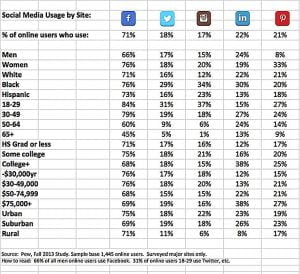This tool is far too important to leave in the hands of the inexperienced.
by Laurie Wink
Facebook, Twitter, YouTube. LinkedIn, Instagram, Pinterest.
In today's competitive marketplace, these social media tools are helping businesses boost visibility, enhance credibility and attract customers. To the uninitiated, the strange names can be intimidating, frustrating and overwhelming.
Northwest Indiana Business Quarterly talked to social media marketing experts who demystify digital lingo and show clients how to harness the power of online marketing. And they share success stories of those who are reaping the benefits.
Why Use Social Media?
Social media is about relationship building.
Darlene McCarty Cohn, owner of D. Cohn Communications in Valparaiso, says people expect to find businesses on social media today.
Her firm designs and manages digital marketing strategies for businesses. These include one-way communication vehicles–such as websites, blogs, newsletters–and two-way social media channels such as Facebook and Twitter. McCarty Cohn says the chief advantage of social media is stimulating conversations that give people opportunities to respond.
“Social media helps give personality to your business,” she says. “It establishes a way of communicating with clientele that can't be done with a website.”
McCarty Cohn keeps up with the evolving social media landscape and figures out which platforms will be of maximum benefit to her clients. “Some will be a better fit for their goals than others,” she says. “It all depends on who is looking for you and where they're looking.
She also teaches a six-week Social Media Marketing Workshop through Purdue University North Central's Office of Graduate and Extended Learning that attracts entrepreneurs, business owners and professionals in nonprofit organizations. The workshop addresses different facets of social marketing and helps people create their own online marketing tools.
Milton Thaxton Jr. and Brandon Griffin teach a three-week Social Media Bootcamp through the Ivy Tech Corporate College that explains how social media marketing differs from traditional marketing. Thaxton is CEO and Griffin is COO of the Social Media Development Group (SMDG), a company they formed in Gary two years ago. SMDG works with a wide range of businesses and non-profit organizations, including the city of Gary.
Thaxton says various types of social media have different tones and draw particular audiences. “We select appropriate channels based on the (client's) audience,” he says. “For example, LinkedIn is more formal than Twitter. Pinterest has high usage among women, and teens are the highest users of Instagram.”
One benefit of social media is the ability to generate valuable information on target audiences. A business would have to pay a hefty fee to a marketing firm to produce similar information.
Griffin says, “It's a tool to help hone services and build a better product.”
How IS Social Media Used?
Consistency is the key to successful social media marketing.
SMDG's Griffin says, “The key to engagement is consistency and realizing you're building a relationship one interaction at a time.”

If you build the channels, people will come, but you'd better continue interacting with them, according to McCarty Cohn.
“If you have a social media platform, you have to use it,” she says. “If people go there looking for a conversation and what they see is a dead page, it hurts your reputation more than anything.”
SMDG helps clients develop a social media policy governing what should and shouldn't be posted, along with a crisis management plan for dealing with posts that “go viral,” rapidly spreading negative news across multiple networks.
Griffin recommends setting aside at least 30 minutes a day to post messages, review comments and respond to them. It takes a daily commitment to nurture relationships with people who can be converted to customers.
Social media professionals do not recommend handing off social media marketing to a young employee or intern.
“Typically, people think social media is a young person's job so they let them deal with it,” Thaxton says. “It's not a role I'd put anyone in other than the person with experience to communicate on behalf of an organization.”
Social media is best handled by one person in a business or organization, preferably someone with excellent communication skills who can create a rapport with audiences. Given the highly targeted, time-consuming nature of social media marketing, many businesses choose to offload the responsibility to professionals.
McCarty Cohn, of D. Cohn Communications, says, “The majority of my ongoing clients are busy doing what they do best and want me to do what I'm good at doing. You have to think like a marketer.”
She asks new clients to give her three months to demonstrate the effectiveness of social media. “It takes time to build attention, get people to talk to you, and see what works,” she explains.
SMDG works in tandem with clients to get messages out and monitor results. “When we engage on behalf of clients, our ultimate goal is for a return on their investment,” Thaxton says.
Who's Using Social Media Marketing?
Brian McShane is president and CEO of McShane's Business Products & Solutions in Munster. His family has owned the company for 94 years and has established a reputation for customer service and giving back to the community. He sees social media as one component of a multimedia marketing strategy that includes billboards and face-to-face customer interactions.

choose depends upon the audience you want to reach.
A centerpiece of McShane's business is the “Buy Local, Give Local” campaign that promotes buying from local businesses to keep dollars in the community. Every month, McShane's contributes a portion of its profits to a local charity. News about the donations is shared on Facebook and Twitter, generating positive comments from the public. YouTube videos produced by SMDG feature testimonials from McShane's customers that are accessible through Twitter and Facebook links on the company's website.
Brian McShane felt it was important to have SMDG educate all of his employees–from delivery drivers to senior managers–about the advantages of social media.
“We wanted everyone in the company to embrace it and understand what's involved,” he says. “Everyone (in the company) has customer contact and social media is all about customer contact.”
McCarty Cohn says, “Getting customers is a byproduct of establishing an active community presence.”
She manages Facebook and Twitter accounts for Regional Federal Credit Union in Valparaiso and regularly posts news about the credit union's community involvements. The posts often show credit union employees volunteering for various local projects.
“They don't use Facebook to advertise loan rates,” she says.
Social media marketing helps businesses rise above their competition. According to McCarty Cohn, Facebook and Twitter accounts increase visibility with search engines, placing a particular business higher on the list when potential customers do an online search.
McCarty Cohn's first social media marketing client was her friend Jack Hines, owner of Hines Plumbing in Valparaiso. She didn't like the way he presented his business on Facebook.
“I thought he was creating the wrong impression,” she says. “It was killing me to see what he was doing and so I took over.” Hines is a consummate professional with a well-run business, she says, so it's important to showcase the company's spotless trucks, neatly dressed employees and quality service.
“If you go to Facebook, you get a better sense of who they are and their corporate culture,” McCarty Cohn says. “These (plumbers) are people who will be coming into your home. You want to know if they're clean and professional.”
Hines also has a sense of humor. Case in point: He promises customers, “We stand BE-HINES our work.” So McCarty Cohn injects a playful tone into Hines Plumbing Facebook page. For example, a post reminding homeowners to check their sump pumps was coupled with a cartoon of a woman saying she always wanted a pool as she dove into deep water in her basement.
“We've also used an occasional butt crack joke,” McCarty Cohn says.
How Do You Measure Success?
Audience response is the key.
That's according to Jeff Fanter Sr., senior vice president for student experience, communication and marketing for Ivy Tech, Indiana's statewide community college system. Ivy Tech uses Facebook and Twitter to deliver customer service to its largest audience: current students.
“Our motto is to take a negative and turn it into a positive within 24 hours,” Fanter says. “If you search Ivy Tech on Facebook, we want you to see this is a responsive place.”
Fanter reports Ivy Tech now has 100,000 Likes on Facebook–the largest of any community college in the country. YouTube videos are popular with a younger audience and are effective in promoting student-related news, such as a scholarship contest.
Twitter, a vehicle for short messages of 140 characters or less, can be quickly read and retweeted. Fanter says Ivy Tech's Twitter feeds are frequently picked up by media outlets. That's particularly the case when the president of the United States visits campus, as Barack Obama did in February. Obama used the event to promote his economic policies to help the middle class. He cited Ivy Tech as an example of a college system that prepares people for good-paying jobs through partnerships with businesses. The campus Twitter feeds about the president were widely retweeted, Fanter says.
Ivy Tech continually analyzes target audience responses to posts in order to identify the most effective messages. “We look at the top five things posted over a period of months and keep posting those types of things,” Fanter says. “If you're not generating a conversation, you're talking to yourself.”
In short, social media marketing is here to stay. The platforms undoubtedly will come and go. Facebook likely will be replaced by a new, yet to be created platform. But there's no time like the present to jump on the bandwagon and use the available social media marketing tools for all they're worth.

